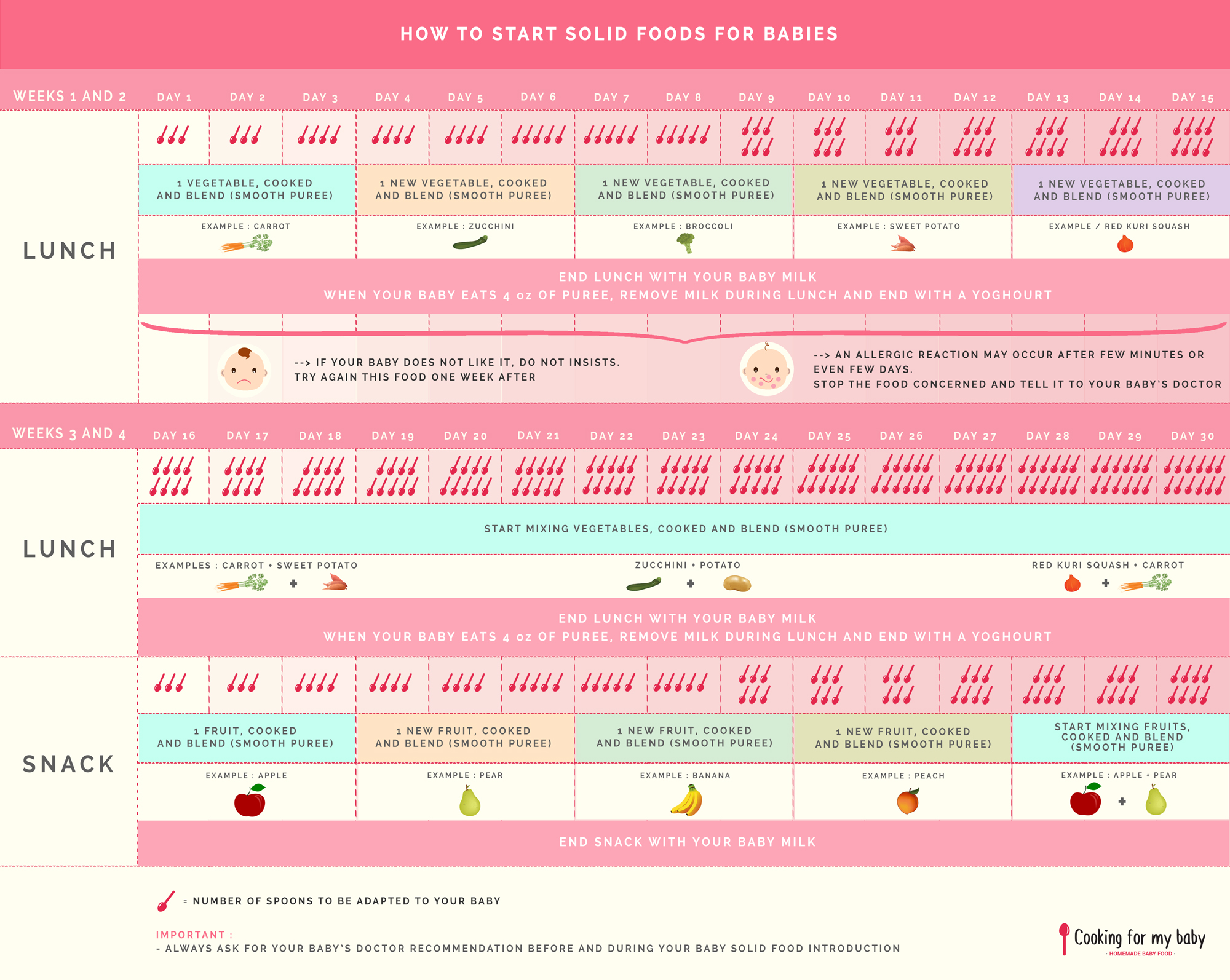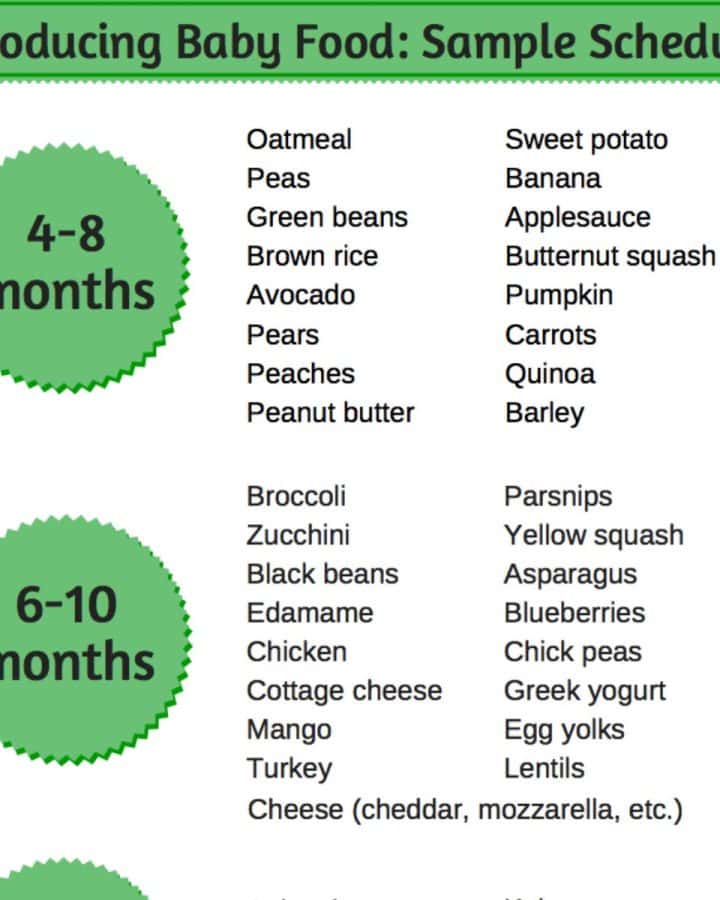Starting solids is an exciting milestone for your baby. Introducing new foods helps them grow and thrive.
Wondering when and how to begin? You’re not alone. Many parents feel unsure about the baby food introduction schedule. The good news? There's a clear path you can follow. Introducing solids is a gradual process. Begin with simple foods that are easy to digest.
Pay attention to your baby's cues and readiness. Every baby is different, but there are common guidelines to help you. This schedule will ensure your baby gets the nutrition they need. Ready to start? Let’s explore the baby food introduction schedule together. Understanding these steps will make this journey smoother for you and your little one.

Credit: www.pinterest.com
Importance Of Baby Food Introduction
Introducing baby food is vital for growth. Babies need nutrients for their bodies. These nutrients help them grow strong. Solid foods provide vitamins and minerals. Breast milk alone may not be enough after six months. Babies need iron from foods like cereal. Healthy foods build a strong foundation. They ensure proper development. Good nutrition prevents deficiencies. It supports overall health. Proper nutrition is key.
Babies reach new milestones with solid foods. They learn to chew and swallow. Solid foods help develop motor skills. Babies practice picking up small pieces. Different textures encourage them to explore. New tastes introduce them to variety. This prepares them for family meals. Eating together strengthens bonds. Introducing solids at the right time is important. It supports healthy growth.

Credit: sandglasstheater.org
Signs Your Baby Is Ready
Watch for signs your baby is ready to start solid foods, like sitting up well and showing interest in your food. Increased hunger and good hand-eye coordination are also key indicators.
Age Indicators
Babies show readiness for solid foods around 6 months old. At this age, most babies can sit up with support. They also start showing interest in food. Your baby might watch you eat or reach for food. These are good signs they might be ready.
Physical Readiness
Physical readiness is important too. Babies should have good head control. They should be able to move food from front to back of the mouth. Chewing motions are also a sign. Another sign is losing the tongue-thrust reflex. This means they don’t push food out with their tongue. These signs show your baby might be ready to try solid foods.
First Foods To Offer
Babies need simple foods first. Start with one ingredient at a time. This helps spot allergies. Try mashed bananas. Or steamed carrots. Applesauce is good too. Peas are a great choice. Wait three days between new foods. Watch for reactions. A rash or upset stomach. Then try another food.
Iron is important for babies. Choose foods high in iron. Meat is a good source. Chicken and beef are great. Also, try pureed beans. Lentils work well too. Iron-fortified cereals are good. Mix with breast milk or water. Offer these foods often. Your baby needs iron to grow strong.
How To Introduce New Foods
Start with one new food. Wait a few days before trying another. This helps you know which food your baby likes. It also makes it easier to find out if a food causes problems.
Watch your baby for any changes. Check for rashes, swelling, or tummy problems. These can be signs of an allergy. Stop the food if you see any problems. Call your doctor if you are worried.
Homemade Vs. Store-bought
Homemade baby food is fresher. You know all the ingredients. It's often cheaper. You control the texture. Store-bought food is convenient. It's ready to use. It often has more variety. It is tested for safety. Homemade may spoil faster. Store-bought can have additives.
Always wash your hands. Clean all utensils. Use fresh ingredients. Store food properly. Check expiration dates. Avoid honey for babies under one year. It can cause botulism. Introduce one new food at a time. Watch for allergies. Puree food well to prevent choking.

Credit: www.familyfoodonthetable.com
Feeding Schedule Suggestions
Babies need a balanced meal plan. This should include breast milk or formula and solid foods. At 6 months, babies can start with pureed veggies and fruits. Small portions are best. One to two tablespoons per meal is enough.
A typical day could look like this:
Time | Food |
|---|---|
Morning | Breast milk or formula, pureed fruit |
Mid-morning | Breast milk or formula |
Lunch | Pureed veggies, breast milk or formula |
Afternoon | Breast milk or formula |
Dinner | Pureed meat or beans, breast milk or formula |
Before bed | Breast milk or formula |
Portion sizes are small for babies. Start with one to two tablespoons. Increase gradually as baby grows. Watch for signs of fullness. Babies turn away or push food away when full.
Handling Food Allergies
Babies can be allergic to many foods. Some common ones are milk, eggs, peanuts, tree nuts, soy, wheat, fish, and shellfish. Start with small amounts. Watch for signs like rash, swelling, vomiting, or trouble breathing. Introduce one new food at a time. Wait a few days before trying another. This helps find out what causes a problem. Keep a list of foods tried and any reactions.
Have an emergency plan ready. Talk to your doctor about allergy action plans. If your baby has a severe reaction, use an epinephrine injector if prescribed. Call emergency services right away. Know the symptoms of a serious reaction. These include difficulty breathing, swelling of the face or tongue, and loss of consciousness. Stay calm and act quickly. Always keep emergency numbers handy.
Transition To Table Foods
Introducing table foods should be slow and steady. Start with soft foods like mashed fruits and cooked vegetables. Offer small bites. Watch for any reactions. Variety is key. Introduce one new food at a time. This helps identify allergies. Monitor your baby's response. If they like it, add more.
A balanced diet is essential. Include proteins, carbs, and healthy fats. Vegetables and fruits are vital. They provide vitamins. Dairy is important too. It provides calcium. Avoid sugary foods. They can harm teeth. Hydration is also crucial. Offer water regularly. A balanced diet promotes good health.
Frequently Asked Questions
When Should I Start Introducing Baby Food?
You can start introducing baby food at around six months old. Begin with single-grain cereals, then move to pureed fruits and vegetables.
What Foods Should I Introduce First?
Start with iron-fortified cereals, followed by pureed vegetables and fruits. Gradually introduce a variety of single-ingredient foods.
How Do I Know If My Baby Is Ready For Solids?
Look for signs like sitting up without support, showing interest in food, and losing the tongue-thrust reflex.
How Much Baby Food Should I Give?
Start with small amounts, like 1-2 teaspoons. Gradually increase the portion size as your baby gets used to eating solids.
Conclusion
Introducing baby food is a significant milestone. Start with simple, single-ingredient foods. Observe your baby's reactions and adjust accordingly. Gradually expand the variety of foods offered. Always prioritize safety and consult your pediatrician if needed. This schedule helps ensure balanced nutrition and happy mealtimes.
Enjoy each stage of your baby's food journey.
.png)





0 Comments